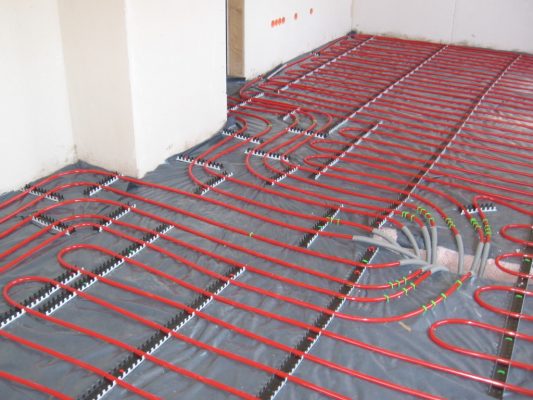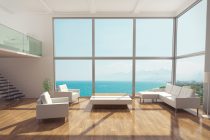Have you ever enjoyed standing in front of a sunny window in winter soaking up the sun’s warmth while the temperatures outside were freezing? Radiant heating, in this case from the sun, is so comfortable because it heats objects, including your body, and not the air. Building Biology teaches us that radiant heat is not only the most comfortable and energy efficient form of heat, it is also the healthiest for us. Although forced air heating and cooling is the most prevalent way to adjust temperature indoors in North America it is far from ideal in terms of health, comfort, or energy efficiency.
You can download this fact sheet by clicking here.
Radiant heat has the following advantages from a health and comfort perspective:
- It is a gentle heat that does not fry dust and other pollutants
- It is silent
- It doesn’t require ductwork which is prone to leakage, dirt and mold accumulation
- It doesn’t blow air around creating drafts and a constant climate from too hot to too cold
- It produces an even comfortable heat
There are many options for radiant heating to choose from. Hot water or steam radiators of various configurations, radiant in-floor (hot water)heating, masonry heaters, in-wall heating and passive solar heating are examples.
Radiators: Radiators are historically the most common form of radiant heat and can be costly to install/repair due to lack of knowledge by modern forced air furnace technicians. Newer European designs are more efficient, and have smaller clearances. Heated towel barss are an example of a clever European innovation that give you warmed towels while heating the room. When installed correctly radiators should last decades. The downside to radiators is that they do take up floor space, typically underneath windows. The purpose of placing them in front of windows is to create a curtain of heat to protect the comfort of those inside the room and to reduce the cooling effect that the glazing has upon the space.
Radiant heat is biologically preferred for people. Our favourite radiator is the sun, from which for most of our history, we have gained our thermal comfort. Radiant heat within a house heats objects far more effectively than forced air systems do. Forced air systems heat the air primarily, and are not as effective as heating surfaces. This surface temperature increase, versus air temperature increase, is better for our bodies. Imagine sitting outside on a warm rock on a cool day as an example. We experience comfort in warmer materials and cooler air. When we are trying to heat the air and not the contents, we find it far more difficult to reach an ideal temperature. (Reference 1) With radiant heat, our thermal comfort range is increased and therefore our well-being is improved. Studies have also shown that we can in fact lower the overall temperature of the space with respect to air temperature when the surfaces are warm. This therefore improves the energy efficiency of the space because you can have your thermostat set at a lower set point than if you were using a forced air system, and maintain comfort while saving money and the environment.
Baseboard radiant hot water heating, although not as efficient as larger radiators, can be used successfully in residential applications. Radiant wall heating, although not common in North America is a dynamic heating strategy and is the best solution for reducing air stratification. Loops of water are installed directly into the wall system and plastered over. Some locations even have ceiling loops, but this would only be required in a situation where one would desire multiple source radiant heat, such as in a spa room.
Radiant Floor: Radiant floor heating is becoming more common in North America. Loop distance or the spacing between rows of tubing is determined by heat loss calculations, to create even heating. By calculating the heat loss, based on construction details such as insulation, window sizes, amount as a percentage of wall area, and locations, an accurate energy representation can be modeled to determine the best layout. Typically the spacing is approximately 6-8 inches apart.
Controllers: There is a variety of tubing used for radiant floor heating including copper, cross-linked polyethylene and synthetic rubber. Radiators typically have copper tubing. Water with a food grade antifreeze, glycol, circulates between the tubing and boiler. For radiant floor heating, various zones are typically set up in a “home-run” style of manifold. Each section or zone of the home is on a separate loop, which begin and end at the manifold, in the utility room. The spaces that require different heat requirements would each have their own zone. Each zone can be independently controlled at the manifold for temperature settings so that, for example, the bedrooms can be cooler, the bathroom warmer, and the living spaces somewhere in the middle.
Typically thermostats for each zone control a manifold and are set at the desired temperature for the room or rooms controlled by it. This set up allows for adjustments in the various zones without affecting other areas of the home. Programmable thermostats can automatically turn the zones off and on according to the occupant’s daily routines to maximize efficiency. Circulation pumps can be either AC or DC depending on electrical needs and sensitivities. If the home has a properly designed passive solar arrangement with thermal mass in the radiant floor, circulation pumps can be run independently of the boiler so that the heat energy stored in the slab through passive gain can be moved to other parts of the building through the radiant floor system.
From a Building Biology perspective the use of radiant floor heating may not be desirable due to the fact that the movement of fluid underneath people can create a biological impact such as would occur with naturally occurring water under buildings. Because of this, Building Biology does not recommend radiant floor hydronic (water) heating. If the installation cannot be altered, consider running the pumps during periods when occupants are not present. Due to the fact that it heats up the largest thermal mass in the house, the slab, it will retain it’s heat, even in severe climates for many hours, and may only need to be circulated while occupants are away in order to provide comfortable heat while reducing occupant exposures.
Note: Radiant floor or wall electric heating is also available but because this method also bathes the space in electro-magnetic fields it is not endorsed by Building Biology.
Want to learn more on this issue? Click the comprehensive online course, here below.
References:
(Reference 1) Learn about homeostatic regulatory systems here. Homeostasis Definition and Examples: Temperature regulation. Biology Articles, Tutorials & Dictionary Online.


